Archive for March 15, 2010
Carnival of souls
March 15, 2010* Due to a scheduling mishap I’m not sure if this showed up in everyone’s RSS readers today, so please note this morning’s Comics Time reviews of several noteworthy monthly comics that came out last week.
* Recently on Robot 6: How Siege and Blackest Night are really doing, Savage Dragon does the Strange Tales/Bizarro Comics thing, and Sara Ryan and friends have advice for comics writers.
* Phoebe Gloeckner says The Twilight Saga: New Moon was the Best Film of 2009. Somehow this does not surprise me at all. In other news, The Diary of a Teenage Girl debuts tonight off-off-Broadway.
* The Doug Wright Awards strike me as a serious consideration of comics whereas most of the other major North American awards programs really aren’t.
* I found Frank Miller’s tribute to Brittany Murphy (no permalink but it’s the only thing there at the moment) surprisingly moving. (Via Heidi MacDonald.)
* I skipped a few of these (plain old missed the 2001, skipped A Clockwork Orange when I saw it was a pan (!), and I still haven’t seen Barry Lyndon despite Kubrick being my all-time favorite director and owning the movie since the Kubrick box set came out a decade ago), but Not Coming to a Theater Near You has rounded out its series on Stanley Kubrick with fine pieces on his three final (and my three favorite of his) films: The Shining, Full Metal Jacket, and the best of the bunch, Eyes Wide Shut. Provided you put any effort into it at all, it’s difficult to write badly about EWS.
* On the Lost front, Todd VanDerWerff’s weekly round-up post has a couple of nice catches, while I’m way behind on the comment thread on my own Lost post for last week.
* Kate Winslet and Sam Mendes have split up. Perhaps she realized that she is Kate Winslet and he is Sam Mendes.
Comics Time: Various (mostly) superhero comics worth your time
March 15, 2010
Last week was a strong week for monthly comics from the front-of-Previews publishers. Here are the ones I read and enjoyed.
Action Comics #887 (Greg Rucka, Eric Trautmann, writers; Pere Perez, Cafu, artists; DC): Not only do I like the idea and image of a giant, mad Kryptonian god-clone slowly walking from Iraq to Pakistan and fucking up everything in his path, I also like the “story” filed by Lois Lane about the rampage that serves as the issue’s narration. A lot of times these things sound so phony, but Lois’s piece on this crazy thing, and how Kryptonian heroes Nightwing and Flamebird have been framed by her dear old Dad, has the the breathless feel of a celebrity Huffington Post column, which is probably the sort of thing Lois would be doing in the real world. Solid stuff. Also, Cafu (cover artist and artist on the Captain Atom back-up) is a phenomenon in the making.
Batman & Robin #10 (Grant Morrison, writer; Andy Clarke, artist; DC): I thought Andy Clarke had a couple of storytelling hiccups here, nothing major, but upon a re-read paying closer attention, they mostly evaporated. In this issue he and Morrison turn Wayne Manor into, as Dick Grayson himself puts it, a sort of game of Clue–a three-dimensional puzzle with secret passages, hidden messages, and portraits of long-dead ancestors that contain clues to a centuries-old secret. It’s like that part in Indiana Jones and the Last Crusade where Indy and Elsa roam around that library looking for the entrance to the catacombs–only this has Batman & Robin! Brainwashed, programmed-to-kill Robin at that! Morrison seems to be leaning too hard on the “Oberon Sexton is Bruce Wayne” thing for it to ultimately pan out, but who knows. This thing is inner-eight-year-old gold.
B.P.R.D.: King of Fear #3 (Mike Mignola, John Arcudi, writers; Guy Davis, artist; Dark Horse): My God, this book just keeps getting better and better. I don’t want to spoil what happens in this issue even obliquely, except to say that I’m very very happy that what happened happened, that there’s a character design in this that is among my very favorite character designs of all time (particularly for how it utilizes Guy Davis and Dave Stewart’s blacks), that every page pays off some years-old strand of story, and that the slow downfall of the Bureau–unfurled with laconic dialogue punctuated by bouts of intense violence–is my favorite ongoing storyline of the last decade.
Criminal: The Sinners #5 (Ed Brubaker, writer; Sean Phillips, artist; Marvel/Icon): Sweet revenge! And wow, Val Staples does yeoman’s work on this book, huh? Again, I don’t wanna be a heel and give away the ending, but it ends on a high note for the arc, and I admire the grin-provoking way in which the final pieces click into place.
Powers #3 (Brian Michael Bendis, writer; Michael Avon Oeming, artist; Marvel/Icon): The obnoxious teenage girl Walker and Sunrise are chaperoning in this issue spouts Brian Bendis’s funniest dialogue in recent memory, while it’s fascinating to watch Michael Oeming’s once-slick Timm-isms give way to this rough-hewn, almost abstracted tumult of shouting faces, blasting energy, spurting blood, and flying, tumbling bodies. This whole issue is visceral in a way that only those grand-guignol killings used to be. Very interesting.
Superman: Last Stand of New Krypton #1 (James Robinson, Sterling Gates, writers; Pete Woods, artist; DC): I sort of wish this issue’s “This is a job for Superman!” moment had been the climax of the final issue of World of New Krypton–I think it would have punched up an ending that sort of felt anticlimactic, what with its murder mystery involving characters we barely know and a series of confrontations with rather marginal space-faring DCU denizens. But that aside, I think this is a rollicking payoff to one of the more underrated superhero runs in recent memory. Brainiac and Lex Luthor vs. Superman vs. Zod is a terrific roundelay, Zod’s behavior here re-villains him after he got a little too cuddly during WoNK, it’s fun seeing the rest of the Superman Family (Superboy, Supergirl, Mon-El, the Legion) show up and slug it out with Brainiac bots for the life of New Krypton, Pete Woods draws some good flying and punching…In a weird way I’m almost glad that J. Michael Straczynski will likely make a clean break from this material, because that means at some point in the relatively near future I’ll be able to own a complete set of trade paperbacks of this whole era of interconnected Superman titles, and on some rainy afternoon I can watch the whole conspiracy and war unfold. Should be a pip.
Ultimate Comics Spider-Man #8 (Brian Michael Bendis, writer; Takeshi Miyazawa, artist; Marvel): It’s a shame the Ultimate line seems to be in the same boat as the Superman line, because Ultimate Spidey has rarely been better. In all fairness, it’s almost always been very good, of course. But the whole “Aunt May’s Crazy House of Teenage Superheroes” idea is a deeply satisfying status quo for the book. For starters, it’s a cool way to keep the universe feeling broad without needing to read too many of its other titles (thank goodness–they’re murdering babies out there!). For another, I’ve always thought Bendis writes these teen characters really well, the dramatic ups and downs of their friendships, and David Lafuente’s drawings of them are simply gorgeous. (His Gwen Stacy is out-and-out crushworthy.) Takeshi Miyazawa fills in here, and pretty strongly if not spectacularly, although the way he does Iceman’s head-icicles grosses me out. (I have a personal phobia about that sort of thing.) I got some laughs out of the names suggested for superpowered teen Ultimate Rick Jones, and I got a reminder that I’ve been enjoying this series for, what, 130 issues now, or something? I suppose I’m mostly curious seeing who becomes the real archvillains in a post-Kingpin, post-Green Goblin Ultimate Spidey world, but I don’t mind taking our time getting there.
Comics Time: Two Eyes of the Beautiful
March 12, 2010
Two Eyes of the Beautiful
Ryan Cecil Smith
self-published, 2010
26 story pages
$5
Based on Kazuo Umezu’s Blood Baptism, this minicomic from Closed Caption Comics stalwart Ryan Cecil Smith–labeled “a grotesque horror manga” on its cover–is funny and queasily suspenseful in equal measure. One one level it’s an experiment in wedding Smith’s thin-lined, loose altcomix style to the doe-eyed, slackjawed strangeness of Umezu’s character designs, and to the spectacle of his horrific “punchline” panels and pages. The wedding’s a happy one, milked mainly for the blackly comedic effect of the contrast. This ironic tinge helps to capture the over-the-top emotional absurdity of this kind of material–in this story, a famous actress literally walks away from her own life and goes into hiding with her daughter on the promise of some sketchy doctor to heal her facial disfigurement if and only if she were to completely disappear from society. (Jeez, I consult the Internet for a second opinion over cough medicine.) Once we learn that the actress has been instructed by the doctor to procure one pure, beautiful young girl for his presumably nefarious purposes, Smith has a lot of fun ratcheting up the tension in horror-comedy style, first via a long, overly specific interrogation of the little girl by the actress, trying to make sure she hadn’t told anyone she was coming over as she slowly locks all the windows and doors to prevent her escape; and second via a pictureless depiction of the actress’s struggle to tie up the little girl, a series of blacked-out panels where the action is conveyed solely through sound effects (“MMMMMPHHHH, KICK, EEE, MMMPHH, PANT, TIE, STRUGGLE, PANT”).
Yet at the same time, given the kinds of cruelty to children we know these comics are capable of, the material is actually quite dreadful amid its goofiness. You hate to think what this vein, horrible woman will do to this poor innocent orphan (you BET she’s an orphan), and then you hate how easy it is for the woman to shift the blame to the little girl when she escapes and seeks aid. I was quite prepared to be sickened by whatever would happen to this poor kid; I dodged a bullet, but I know it was only through the restraint of the cartoonist that this occurred. For a formal exercise, it’s striking stuff.
Comics Time: All-Star Superman
March 11, 2010

All-Star Superman Vols. 1 & 2
Grant Morrison, writer
Frank Quitely, artist
DC, 2008-2010, believe it or not
160 pages each
$12.99 each
For today’s Comics Time review, please visit The Savage Critics.
Carnival of souls
March 10, 2010* Remember when TV on the Radio’s Tunde Adebimpe drew a picture of David Bowie for my David Bowie sketchbook? The Yellow Bird Project is now using it as a t-shirt design to raise money for Haiti relief. I’m very excited about this and am grateful and glad to have been a part of it. Buy one!

* I was sad to hear about the death of Corey Haim. Prior to the release of Crank: High Voltage, the only film of his I’d seen all the way through was The Lost Boys. (Blown Away I tended to fastforward to the good parts back in middle school.) But The Lost Boys is obviously a marvelous movie, and watching it recently, one of my favorite parts was Haim’s one-of-a-kind performance as some kind of junior-high dandy.
* Todd VanDerWerff liked last night’s Lost more than I did. He makes a decent case.
* As a big fan of both Ta-Nehisi Coates and Ghostface Killah, I’m please to be able to say this: Ta-Nehisi Coates on Ghostface Killah.
Comics Time: Savage Difficulties
March 10, 2010Today’s Comics Time review, which was to be hosted at the all-new all-different Savage Critics, has been gobbled up by a host switchover. I will be able to reconstruct it and post it tomorrow.
In the meantime, may I suggest you add the new Savage Critics RSS feed to your RSS readers. The switchover isn’t automatic, so if you previously subscribed, you’ll want to update it.
Thank you for your interest.
Lost thoughts
March 9, 2010SPOILERS SPOILERS SPOILERS HO
* “May I please see the storage facility, Mr. Venkman?”
* Here’s a phrase I never expected to hear in conjunction with Lost: “Directed by Mario Van Peebles.”
* Tania Raymonde = Great Googly Moogly
* It would be odd of Ben’s dad (legitimately great make-up job on Uncle Rico/the werewolf, by the way) to suggest that their life would have improved if they’d stayed on the Island had a nuclear bomb gone off and sunk it to the bottom of the sea, right?
* But who knows what kind of strange rules apply in a world where high school principals exercise dictatorial control over the budget and teachers jockey for power to replace them in the middle of a school year.
* Arzt is getting annoying. (Getting?–Ed.) I sort of wish Locke had been the guy riding shotgun with Dr. Linus’s scheme to take down Principal Walter Peck, but I suppose that sets up all kinds of parallels they weren’t prepared to do.
* I also sort of wish Illana weren’t such a pivotal character right now, because we have so little to go on with her. We’re less attached to her than to any other surviving character on the entire show. She is to the cast what the Temple set is to Lost sets.
* One way I could tell in this episode that things are moving to a head is that they had two climactic confrontations: Jack and Richard, and Ben and Ilana. Either could easily have been the focal point of an entire episode, and would have been, in an earlier season–or hell, earlier in this one.
* As it stood, I think I preferred the Jack and Richard scene. I loved seeing both men pushed past their limits: Richard in panicked despair, divided between shadow and light as he frantically explains why he’s now so desperate to die; Jack in crazy-eyed, careless confidence, bound and determined to find out the reason he’s now so sure he has to be there, a Man of Faith to rival Locke from earlier in the show. Good stuff.
* Ben’s scene was as well-acted as you’d expect from Michael Emerson, and I bought it, but again, using Ilana as his foil made it feel like a dress rehearsal rather than closing night. Imagine if his interlocutor had been Locke, Jack, Kate, Sawyer, or Richard. (Moreover, you’d think Miles, Lapidus, or Sun would have something to say about forcing a man, even Ben, to dig his own grave.)
* So maybe the episode was a bit…off-balance? Given the subject of the flash-sideways, Ben’s story should have been the main one. But you had a big moment with Jack, Richard, and Hurley, while Fake Locke showed up as well. It dulled the impact.
* I always enjoy a good slow-motion smiley reunion scene on this show. With all the team-ups and split-ups and bumping into each other in the jungle and storming off in a huff that goes down, it’s occasionally nice to get a reminder that a lot of these people really like each other, or did at one point, and care about one another. We care about them too!
* Miles psychically detecting Nikki & Paulo’s diamonds was a hoot. It was like the writers raced to pick up something even the most die-hard fans wouldn’t have put together. (That said, I’m sure someone said “hey, wouldn’t Miles notice Nikki & Paulo’s diamonds?” before, but I almost feel bad for that person.) Would have been nice if he noted they’d been buried alive, but still.
* So Fake Locke’s posse is on Hydra Island, huh? I wonder if Sawyer and Kate will have one last roll in the polar bear cage, for old times’ sake.
Exceedingly brief carnival of souls
March 9, 2010* Recently on Robot 6: The Best Show on WFMU and send Tom Brevoort a postcard.
* This dude made his D&D room into an actual dungeon. Living the dream. (Via Topless Robot.)
* See you tonight for Lost thoughts!
Comics Time: Naoki Urasawa’s Monster Vols. 6-18
March 8, 2010
Naoki Urasawa’s Monster Vols. 6-18
Naoki Urasawa, writer-artist
Viz, 2006-2008
200+ pages each
$9.99 each
It’s not quite accurate to say that Monster got away from Naoki Urasawa in the end. Never–not as volume after volume of increasingly baroque hidden connections, repressed memories, and buried Communist conspiracies multiplied and refracted like a screensaver, not even as he added still more characters to a cast that already made The Lord of the Rings look like No Exit in Volume frickin’ 18–did Urasawa come across as anything but totally in control. Each time a new concept was introduced, I knew it would tie into someone or something we’d already met in a way that would nonetheless surprise and delight me. Each time a new character came along, I knew I’d be made to care about this new sad-sack with either a tormented past or an overdeveloped sense of right and wrong. Every twist made it clear I was in the hands of a master.
Yet for all that I knew Urasawa was making conscious decisions at every turn rather than running around frantically to keep all the plates spinning, I can’t help but feel that by the end, he’d made some bad decisions, spun some broken plates. First and foremost, remember when Dr. Tenma was the main character? Nominally I suppose that’s still true, as the final showdown with the titular character is with him. But by then you’re just as likely to be spending screentime with Grimmer, or Nina, or Eva, or Reichwein, or Lunge, or Gillen, or Verdeman, or even random characters who are in and out in the space of one volume like Martin or Milan or the people of Ruhenheim. (That I remember the vast majority of those names off the top of my head speaks well of the material, but still.) Without the singular, driving focus of the original concept– A doctor saves a little boy who grows up to be a serial killer and now must hunt him down–the story’s sprawl starts to pull it apart a bit, and the climactic confrontation is robbed of some of its weight.
Then there’s that confrontation itself. It’s distinguished by the strongest image in the series, a searing two-page spread that screams “instant classic.” And it undoubtedly brings to bear the full weight of the preceding 17 1/2 volumes of cat-and-mouse, before knowingly (if a wee bit over-familiarly) pulling the rug out from under the moment. The problem is that for, oh, four or five volumes leading up to that moment, it’s felt like one climax after another. I know this could be an artifact of the translation and adaptation process, but the dialogue really starts to feel artificially stretched out in the home stretch, with short sentences split between five panels across a full page in some cases just for dramatic impact. Of course, do that too often and the impact is dulled; do it for a quarter of your series and it starts to feel like a neurotic tic. Particularly given how many times this is done to depict a character reaching into the recesses of his or her memory and pulling out something dark and terrible but stopping just short of dragging it into the light for good, the repetition begins to grate, and to make it difficult to distinguish final revelations from teases.
That said, this stuff is as thick and engrossing as quicksand. The steady rhythm and rock-solid character designs are pretty much tailor-made for getting lodged in your head and replayed as you drift off to sleep at night–I for one had a pretty messed-up dream last night about my wife and I fleeing through a hospital from a monstrous child-thing. Several sequences are genuinely chilling: The standouts for me are the cruelty of a child who briefly fell under the tutelage of the title character, the dark storybooks of Klaus Poppe (beautifully drawn in a vastly different style; remember that storybook about the train in the Dark Tower series?), and the ending itself. I’m not sure how sold I am on the book’s constant waxing philosophical about good, evil, and the value of human life, particularly the hard line it makes Tenma take against killing even in immediate self-defense or the defense of others, given the track records of the characters he tends to be pointing his gun at in these situations. But at the same time, the material concerning the abuse of children, the mad ambitions of people with lots of power and little oversight, and the notion that secret, forgotten deeds committed in the name of defunct ideologies can reverberate indefinitely with disastrous consequences is all very effective. That last bit, it strikes me now, is symbolized by the sign of the long-gone Three Frogs pub that becomes so pivotal: An artifact that has outlived its artisans, a symbol that has outlived what it symbolized, yet which still has a potent ability to harm. From the high concept on down, Monster is a story of unforeseen consequences, which are often more awful than the awful things we meant to happen.
Carnival of souls
March 8, 2010* Here are the 2010 Oscar winners.
* Not Coming to a Theater Near You’s Stanley Kubrick retrospective is up to Lolita and Dr. Strangelove. Here’s a fine bit from the former by Katherine Follett:
In the novel, Humbert believed in his arrogance that lusting after a basically non-sexual girl was somehow the mark of a rare aesthete, as if he had an appreciation for inaccessible modern art, while adult women were the equivalent of banal, eye-pleasing landscapes. But now that Lolita has the body of an adult woman, and Humbert’s interior voice is nonexistent, we’re left with no special reason why Humbert is drawn to Lolita, other than ordinary–and totally understandable–lust.
Sue Lyon was a dime, obviously, but I still thought the film got “she’s too young” across effectively enough. Meanwhile, I enjoyed Timothy Sun’s take on Strangelove for how systematically it reminds us that American cinema’s greatest satire includes characters called Buck Turgidson, Jack T. Ripper, Merkin Muffley, and Major Kong.
* Dan Nadel on Jim Rugg & Brian Maruca’s Afrodisiac. Interesting point of comparison to Josh Cotter’s Driven by Lemons.
* Loving, loving, loving Zak Smith’s Playing D&D with Porn Stars. Here’s a killer pair of posts running down the pros and cons of the game’s Demons and Devils, and here’s a marvelous rumination on the way players flip back and forth between their in-game and real-world selves while playing. I mean, for real, I’m running out of superlatives.
* Recently on Robot 6: JMS as the third leg on the Grant Morrison/Geoff Johns footstool and Jared Stumpenhorst’s LOST 365.

* I’m starting to think it’s weird that trailers show you the entire plot of a movie. Like, this Iron Man 2 trailer leaves pretty much no surprises for the first three reels, right? But hey, War Machine.
Would you like to buy over 800 pages of Lee/Kirby Fantastic Four for eight bucks?
March 7, 2010The 848-page Fantastic Four Omnibus Vol. 1 hardcover, for $8.24. Act now, because I assume this price won’t last.
Tons more deals via Bully, but that one strikes me as particularly outrageous. (Via Ken Lowery.)
Caprica thoughts
March 6, 2010It’s been a while, hasn’t it? And that’s probably telling. I watched the pilot a little before it aired, on DVD. I waited a couple weeks before watching the next two episodes back to back, on TiVo. Then I waited until last night to watch the next three episodes in a row as well. Now, Caprica isn’t a show the Missus has any interest in, so watching it live isn’t an option, in all fairness. But the same could have been said of Battlestar Galactica and The Sopranos, and in those cases I’d just wait until she went to bed–nothing could stop me from watching new episodes the night they first aired. Part of that was fear of getting spoiled the next day, which I’m not as concerned about regarding Caprica, since no one I know seems to be talking about. (That’s probably telling, too.) But mainly, I’m just in no hurry to watch the show. Last night’s three-episode marathon felt almost like homework.
Why? Jim Henley was close, but not quite there, when he talked about how unlikeable the characters are. I can get around that–where would The Sopranos have been without unpleasant people? What I have a harder time with are characters who are unexciting. It occurred to me sometime last night that Caprica has no Starbuck, no Baltar, no Bill Adama (well, you know what I mean), no Colonel Tigh, no Six, no President Roslin, no Apollo…no one whose continuing adventures I’d be excited to see, regardless of their level of bastardry. No one whose smiles or rages intrigue me, no one who makes me laugh, no one who makes me cheer, no one who makes me shudder. Instead it has a lot of people in expensive clothes, hiding how they really feel all the time, until it finally comes out in some big scene of melodrama, which ultimately feels just as contrived as their buttoned-up anal retentiveness elsewhere.
It’s just very difficult to get invested in Daniel and Elizabeth Graystone’s troubled marriage when we’ve never seen what would make either of them worth sticking around with. It’s difficult to feel for Joseph Adama’s plight as a man torn between two cultures when we haven’t seen what he’d really contribute to either. It’s tough to really get into the semi-villains like Sam Adama and Sister Clarice when the only thing that elevates them from cliche is an equally contrived tweak of conventional mores–look, the gangster is GAY!/look, the religious zealot is a SWINGER! Sasha Roiz’s Sam is probably my favorite performance on the show–he wears those clothes gorgeously, his eyes are intelligent, he comes across as the most at home in the show’s ersatz Coppola tones–but he’s still hampered by the rote construction of the character. Sister Clarice I’d be happy to never see again. James Marsten’s Barnabas is even more dire.
I’m also increasingly convinced that starting the show with the death of children was a big mistake. Where can you go from there, tonally? The answer, as it turns out, is pretty much nowhere–it’s just been a dour, sour show ever since. I can’t remember laughing a single time, or being on the edge of my seat. I think the one episode that managed to buck this somewhat was the fifth, “There Is Another Sky.” Between Graystone finally pitching the Cylon to his board of directors as the ultimate pet/slave, setting up the technological revolution that we viewers know will eventually lead to the destruction of civilization, and the lost avatar of Tamara Adams discovering she’s all but indestructible in the virutal world within which she’s trapped, we finally had genuine thrills–moments that weren’t mired in the inability of a bunch of jerks to properly process their grief. I mean, it wasn’t perfect–the Tamara stuff felt really Matrix-y and dated, while a third storyline involving the cultural customs of the Taurans left me scratching my head as to how almost all of the interplanetary differentiation and strife present here disappeared in time for Battlestar. (I assume the First Cylon War served as a great unifier, but it’s still weird that Bill Adama never talked about this stuff when it we’re being told it’s such a formative element of his young adulthood.) But it was something. In a weird way, it was where the series probably should have begun. Last night’s episode was a step backwards, unfortunately. I hope they can get things moving again.
Carnival of souls
March 5, 2010* Behold: The Secret Origin of Destructor.

* New York Noise is a terrific music show that airs on New York City’s public television station NYC TV, focusing on local bands, local labels, local video directors, and formerly local members of all three categories. The list of artists I love that I first discovered through this show is really just outrageously long, but the best example I can think of is when, in the course of back-to-back videos, I heard the music of Klaus Nomi and Antony & the Johnsons for the very first time. My wife and I sat there like someone had just detonated an atom bomb in our heads. Seriously, New York Noise has been a vital lifeline to the city’s musical bounty for me for years. Unfortunately, the channel has suspended production of the show. Please sign this petition, join this Facebook group, and email Mayor Bloomberg about it. I’ve done all three and hope you will too. (Via Pitchfork.)
* Lost links: Some intriguing catches in Whitney Matheson’s weekly “best of the Lost comments” post, and here’s a working link for Todd VanDerWerff’s weekly follow-up post (thanks, Jesse M.).
* Stuart Immonen draws a mean Ben Grimm.
* Don’t know how I missed this when it first appeared, but I enjoyed Ted Naifeh’s Gary Numan and David Bowie-influenced Batman sketchbook.
* One of my favorite bloggers, Jon Hastings lists his top 20 films of 2009.
* Real-Life Horror #1: The Obama Administration is reportedly considering trying 9/11 mastermind Khalid Sheikh Mohammed in a military tribunal rather than a civilian court after all. Land of the free, home of the brave.
* Real-Life Horror #2: Matthew Yglesias ponders the differing reactions to those who murder while Muslim versus those who don’t.
* Your quote of the day comes from Mike Barthel:
If our indie bands are going to be pretentious and juvenile, why must they be either tweely earnest or blue-collarly retro? Why can’t they instead evoke that particular feeling of driving mournfully around the suburbs at night in between rewatching The Crow?
Amen!
Carnival of souls
March 4, 2010* Recently on Robot 6: Sweet Batman & Robin art from Cameron Stewart and Andy Clarke, Hope Larson on Mercury (via Kiel Phegley), and Eliza Dushku departs from Wizard Worlds Anaheim and Toronto.
* Todd VanDerWerff’s comment-based Lost follow-up reveals that fannish tensions are running high right now, something I wasn’t aware of at all.
* I’m filing this Tom Spurgeon review of Daniel Clowes’s Wilson away for later use.
* The character of the week at We Are The LAW is Orko! I never hated him. Here’s Rob Bricken doing him 8-bit-style, while TJ Dietsch’s version made me laugh out loud.

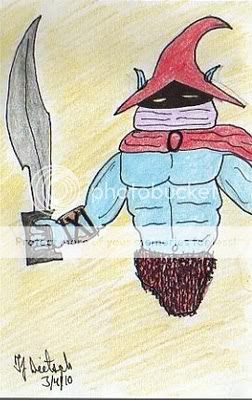
* Wowsers, this SOTA Toys statue of H.P. Lovecraft’s Dagon is pretty terrific. Also eldritch, tenebrous, cyclopean, etc.

* Renee French is creepy: part 3,892 in a continuing series.

Carnival of souls
March 3, 2010* Well, how about this: The Strange Tales hardcover comes out today, and with it come the release of my final three Strange Tales Spotlight interviews for Marvel.com: Nick Gurewitch, Brian Maruca, and James Kochalka. That first one’s even a bit newsy: There are more Perry Bible Fellowship comics and more Marvel-Gurewitch collaborations in the offing. But for me, these three interviews represent the last leg of my literally years-long involvement with the project, which has now seen me interview all thirty creators involved with the book. What a pleasure!
* Christopher Handley’s attorney Eric Chase explains the nebulous legal Calvinball that led him to plead Handley out in his comics-related obscenity case. Turns it the “I know it when I see it” standard makes cases like these difficult to defend, which Chase feels is precisely the most dangerous effect of that standard. (Via Tom Spurgeon.)
* Recently I saw people linking to some dopey-sounding essay about Why Don’t Jews Write Fantasy; Spencer Ackerman responds to this call for a Jewish C.S. Lewis and a Jewish Narnia by pointing out the existence of Stan Lee, Jack Kirby, and the Marvel Universe. That’s pretty brilliant. I mean, I know everyone talks about how superheroes are by and large the creation of American Jews, but locating them in the fantasy tradition that way, as a unique alternative to the epic fantasy of Tolkien or the allegorical fantasy of Lewis or the sword and sorcery of Howard and so on, strikes me as very smart. I know there are better-educated consumers of fantasy reading this blog–perhaps you’d care to chime in on this in the comments.
* I’m as excited as Sparkplug is to see John Hankiewicz’s Asthma placing so highly in a pair of recent Top 100 Comics of the ’00s lists. That is a major, major work, woefully underdiscussed.
* Cameron Stewart is posting black and white pages from Batman & Robin #9, and they’re striking. Those blacks are really powerful and multidimensional.
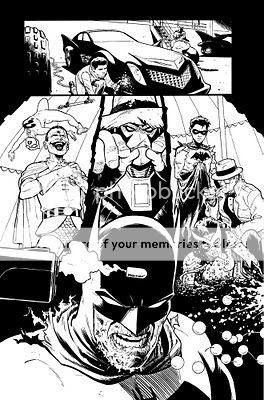
* Josh Cotter has started up his annual experimental-comics project March Hare. Guy’s good.

* The quote of the day is from Zak Smith: “The main points of the game are: hanging out with your friends, inventing strange things, and problem-solving–all of which are maturity-scalable activities.”
* Congratulations to the same-sex couples of Washington, DC, who could get married starting today.
* I feel like Todd VanDerWerff’s weekly Lost post is a little off this time around. I don’t know that waxing philosophical about how the Allies did terrible things in World War II too is a particularly illuminating point of comparison here, you know? VanDerWerff also tries to shunt the “good vs. evil” debate into the “destiny vs. free will” one, but given who he feels represents each side, that sure is stacking the deck; he then takes the “destiny vs. free will” thing and pins it to a particular line in the first episode of this season in a fashion that strikes me as out-and-out Doc Jensen-y. But hey, if Lost has taught us anything, it’s that everyone has an off week.
* On that note, swing by this week’s Lost comment thread if you haven’t already. The joint is jumpin’!
Lost thoughts
March 2, 2010SPOILER ALERT, SPOILER ALERT
* And Sayid gets beaten again! Has he ever won a fight? Was there a touch football game with Walt in the early days he managed to come out on top of or something?
* Dogen and Lennon, we hardly knew ye.
* I’m gonna go ahead and attribute Sayid’s dirty deeds in this episode to the aforementioned “darkness growing inside him.” Sayid is someone who’s done a lot of terrible things, though mostly during his offscreen years with the Republican Guard, but he was obviously extraordinarily repentant about that. Moreover, until tonight I really hadn’t seen him do anything unforgivable on the show itself. (I’d have shot Young Ben too. Baby Hitler, if they ever invent time travel, I’m coming for you, asshole.) The point is that the show has never framed Sayid as a bad person deep down–they’ve framed it that he thinks this is the case, but they’re always showing us evidence to the contrary. So it’s a big leap for him to suddenly be walking around smirking about murder, something he’d never ever done before no matter who he was in the process of killing–hitmen, golfers, Others, future archvillains, you name it.
* But Sayid’s corruption makes me wonder what the heck Richard was talking about last season when he warned Sawyer and whoever else that if he took Ben to be healed in the Temple, he’d never be the same. Obviously there’s some other kind of process at work with Sayid than whatever saved Ben, since Ben is clearly not in thrall to the MIB the way Sayid is (or the way crazy Claire is). What we’re seeing from Sayid is more similar to the cold evil of Rousseau’s teammates when she was in that kill-or-be-killed situation with them long ago.
* I’m also wondering how separate the Others community seemingly overseen by Dogen at the Temple was from the Others community ostensibly run by Ben and Richard at the old Dharma Village. Based on tonight’s evidence, the Temple Others really were servants of Jacob, doing his will and often being quite shady in the process. But they still seem miles away from the neck-snapping, boat-detonating, Walt-kidnapping, Sawyer-shooting, Charlie-hanging, Juliet-branding, Michael-blackmailing, Charlie-drowning antics of Ben, Tom, Ethan, Goodwin, Miss Klugh, Mikhail, Pickett, and the rest of that crew. Was Jacob down with all that? We’ve gotten the impression that the MIB was, I dunno, impersonating Jacob in that cabin for quite some time–was Ben getting orders from the wrong guy without knowing it, or was he getting orders from Jacob but twisting and perverting them, or is Jacob just as much of a creep as the MIB?
* I suppose it’s also worth pointing out that Ben didn’t seem to make the connection between the smoke monster and Jacob’s arch-enemy back when the monster became Alex and talked to him. It seems like he’d thought of the Monster as “The Island” in some way, up until the moment Fake Locke transformed into the Monster, killed those dudes in the base of the statue, then transformed back and admitted they were one and the same. So obviously Ben was in the dark about what was really going on for a long time.
* Come to think of it, Ben’s dead mother appearing to him was the first step of his life of crime, right? So MIB’d been monkeying with him for a very long time.
* Anyway, back to the episode itself:
* I can’t be the only person who kind of enjoyed watching the smoke monster wreck shop in the Temple, right? First of all, killing Others is always fun, and the more the merrier. Secondly, I was kind of disappointed in the Temple as a set. The use of an outright namedrop from the mouth of Hurley is not enough to offset how syndicated-ripoff-of-Indiana-Jones it felt. Compare and contrast with the wondrous ’70s EPCOT specificity of the Hatch–the Temple comes off generic and unimaginative. I don’t mind leaving it behind. But mostly, yeah, kill those Others!
* Crazy Claire isn’t just crazy and/or evil, she’s also obnoxious. That’s not a bad choice for that role.
* There aren’t a ton of characters who could sustain a whole episode of Lost without any Sawyer or Jack material in it. Sayid’s one of a very few.
* Nadia’s pretty.
* I was pulling hard for Eko or Jin being related to Sayid’s brother’s money mess, and thus was about 50% disappointed. But Keamy was a nice surprise! What a creepy, unpleasant man. Kevin Durand, yet another example of the show’s nigh-flawless villain casting. Great to see him back. And I’d forgotten until I hit Lostpedia just now to look up Durand’s name that his underling, Omar, was his underling in Widmore’s mercenary crew, too.
* No Other in Sayid’s flashsideways, though. I suppose Keamy fulfills that role in a sense. Or perhaps there’s some narrative significance to Others appearing with Jack, Locke, Kate, and Claire, but not Sayid…
* So how did Jin go from being held up in customs to Keamy’s freezer? Does the presence of Keamy mean that my long hoped-for connection between Jin and Eko in L.A. won’t happen? Does it mean that Widmore is involved as well?
* I’m wondering what the hell Sawyer and Jin were sitting around talking about while Fake Locke and Claire destroyed the Temple. Perhaps Jin was able to convince Sawyer that if crazy Claire thinks following Fake Locke is a good idea, it’s probably a bad idea.
Carnival of souls
March 2, 2010* Recently on Robot 6: Lots of Avengers news, to match lots of Avengers news elsewhere. That is a lot of Avengers product. If I were Tom Spurgeon I’d now deliver a funny “whodathunkit” gag about the Avengers and Green Lantern being the biggest franchises in comics.
* Rob Bricken hoists plagiarist Nick Simmons with his own petard. If you read any single post about this whole debacle, make it that one. But if you want, you can throw in Tom Spurgeon’s depressing analysis of the moral relativism of many young artists and fans commenting on the matter.
* Oh God! Oh Christ! Oh Jesus Christ! A Muppet Wicker Man! The ending, as you’d expect, is a killer.
* I always enjoy Chris Butcher’s Previews liveblogging: Part One and Part Two, for your pleasure.
* HBO has officially greenlit A Game of Thrones Season One. I’m looking forward to it, even though I don’t have HBO.
* Just a reminder: I typically have my weekly Lost thoughts post up by, oh, 11:30pm Eastern time at the absolute latest, frequently way before then. (I tend to watch it starting at 10 rather than 9, hence the delay.) I’ve really enjoyed the comment-thread discussions lately, and the more the merrier.
Comics Time: Naoki Urasawa’s Monster Vols. 4-5
March 1, 2010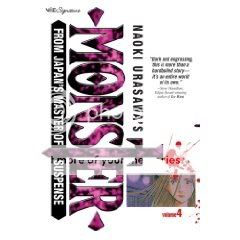
Naoki Urasawa’s Monster Vols. 4-5
Naoki Urasawa, writer/artist
Viz, 2006
200+ pages each
$9.99 each
By now it’s clear that that sore-thumb final chapter of Volume Two, where Tenma briefly brings sunshine into the life of a mercenary and his heretofore damaged adopted daughter, isn’t the exception, but the rule. Monster, it seems, will be not just about Tenma’s game of cat and mouse with Johan, the serial killer whose life he saved, nor even just about that plus the parallel chases of Inspector Lunge as he hunts for Tenma and Johan’s sister Nina as she too hunts for Johan. Instead it’ll be like, I don’t know, The A-Team, where Johan, Lunge, and Nina’s quests will intersect with a variety of conflicted medical professionals, memorably evil criminals, memorably humane ex-criminals, shadowy governmental agents, and so forth in each “episode.” We’ll bounce them off our leading players, an incremental revelation will be proffered to the heroes, an epiphany will be reached by the guest stars, someone will be murdered by Johan or his minions, and the cycle begins anew. A lot of this is Velveeta, but I’m never not racing through it to find out how this ties into the increasingly byzantine and red-herring-laden backstory of Johan, or who’ll get capped and how and why. It helps that Urasawa bothered to situate the story not just in some generic “present day, local location” setting, but in post-Cold War Germany and its medical community; like the realistic backgrounds provided by his studio, the details of reunification, the far-right underground, the role and status of immigrants, the expertise and moral dilemmas of its doctor characters–they all give the story weight, depth, and shading even at its broadest and most black-and-white. It’s getting a little hard to keep track of all the square-headed middle-aged men with pointy noses, however, which is what makes the few character designs that deviate from that norm–the balding, hulking, doughy serial killer Jungers, for example, his eyes whited out by the reflection off his glasses–such a pleasure to encounter. In that same spirit, Monster seems a saga of simplistic structuring shored up by entertainingly complicating wrinkles.
To the lighthouse
March 1, 2010In one scene in Shutter Island, Leonardo DiCaprio’s Federal Marshal Edward Daniels interrogates a jovial but visibly on-edge patient at the mental institution to which he’s been sent to investigate the disappearance of a patient. In order to buy time to pass Daniels a clandestine note, the patient asks his partner Chuck to get her a glass of water. When he returns with it, she picks it up and starts drinking it. In the next shot, she’s just miming drinking it and putting it down–there’s no glass there at all. In the next shot, she puts it down, empty. In the next shot, it’s half full. None of this is ever noticed by any of the characters. I doubt it was noticed by very many people in the audience.
That, in one sequence, is why I love seeing Martin Scorsese movies. You know, maybe it’s my immersion in comics that’s leading me to call this out–my increasing conviction that greatness stems from using as tools the facets of your medium others see as mere props. But when I sit myself down and place myself in the hands of someone like Scorsese, there’s a good chance that he’ll, say, be deliberately sloppy with shot-to-shot continuity–the positions of the actors’ bodies don’t line up properly, their mouths aren’t synced with the dialogue, snippets of time will disappear like miniature jump cuts–simply to show that something’s…not…quite…right. It’s not some jittery effect, what back in the Natural Born Killers days people used to call MTV editing; the effect is every bit as classic-Hollywood as the cliffs and towers straight out of Hitchcock, deep focus shots straight out of Welles, or the mightily effective, star-of-the-show contemporary-classical score. It’s just a sign that the filmmaker is in control of his medium, and is going to spend the next couple hours using it. It’s not a guarantee of success, necessarily–I understand that people’s mileage with late-period Scorsese varies, and I understand why. But it’s a guarantee of effort. It’s a sign that if the movie fails, it’s not failing because it’s trying to do something else but falling short. It’s doing what it wants to do.
What does it want to do? Two things most importantly, I think. The first, which is another reason I enjoy Scorsese movies, is showcase performances. This starts with his lead. Leo has his detractors, obviously, but in much the same way that his Departed castmate Matt Damon has parlayed his vacant all-Americanness into a career of playing cold-blooded killers, DiCaprio has taken the pinched features of his aging babyface and, in his collaborations with Scorsese at least, transformed himself into a little ball of seething guilt and rage. He’s like Hollywood’s Red Lantern. I empathize with manner in which his characters constantly battle back the knowledge that they’re not up to the task at hand, whatever it may be. Daniels, with his nightmares and his nightmarish memories constantly bleeding into one another, constantly looking like a drowned rat, may be the apotheosis of that type.
Beyond that, I wish I could remember who I read saying that the movie veered dangerously close to Martin Scorsese’s Circus of the Stars, but you say that like it’s a bad thing, whoever you are! Jackie Earle Haley out-Rorschaching Rorschach, Elias Koteas being creepy and grotesque, Max Von Sydow (who has been old for close to 40 years, somehow) being a good German, Ted Levine sending out sonar echoes of Buffalo Bill (The Silence of the Lambs being another super-obvious reference point for Marty) as the spectacularly bloody-minded warden, Ben Kingsley as bald and sinister as ever…I do not mind attending this circus, no siree. Emily Mortimer and Michelle Williams both impress and discomfit in their roles as the women Daniels sets out to rescue as well.
Which leads us to the other thing Shutter Island wants to do, a high-wire act linking Scorsese’s straightest thriller since Cape Fear with genuine, real-world horrors. I say by all means let the corpses of Dachau be used to frighten and terrify. Let the execution of the guards by the American liberators go on and on like a sick joke, unfolding horizontally as if each soldier patiently waited his turn to slaughter the slaughterers. Linger on the frozen bodies as they pour out of the cars of a freight train like a glacial waterfall. And later, dig into the horror of the murder of children. Cover the actors with their blood, carry around their bodies, wade into the water in which they drown and float. Make your whole movie about the mind’s inability to cope with horror, to the point where the end comes like blessed relief and the rollicking delivery of the twist feels like a blade cutting away the bad parts. Don’t we have enough monsters?
Carnival of souls
March 1, 2010* Recently on Robot 6: Jim Woodring’s moleskine, Lisa Hanawalt’s t-shirt, Jim Lee’s cover, and Scott Pilgrim’s soundtrack.
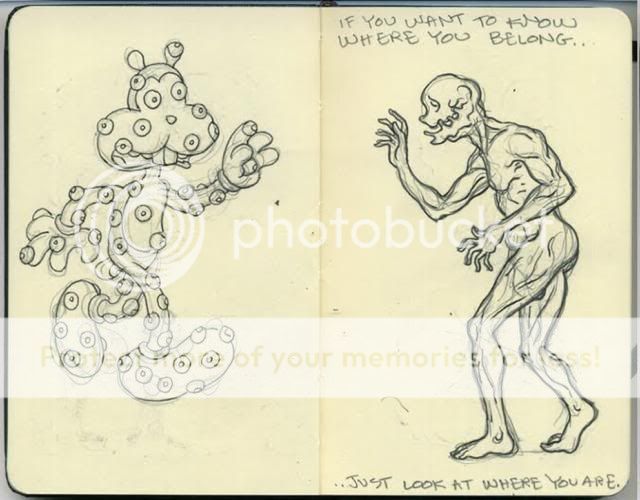
* More Destructor art over at We Are The LAW, from David Paggi, Rob “Topless Robot” Bricken, Ryan “Agent M” Penagos, and Matt Powell.


* A Frank Santoro golden oldie, straight outta PULSE! magazine.

* I really dug “The Symbiote’s Effect on the Mind” by Aaron Zvi Felder. Be sure to click through and read the whole thing.

* Arthur Magazine has launched a new dedicated webcomics portal with the latest installment of Jesse Moynihan’s very good GWC.
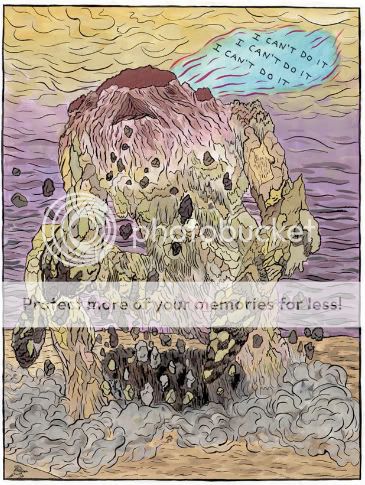
* Brian Ralph does Jack Kirby!

* Not Coming to a Theater Near You is doing a Stanely Kubrick retrospective. ‘Nuff said.
* Is pacifism objectively pro-fascist? Is any one thing ever objectively pro-any other thing? George Orwell once thought and said so, but changed his mind.
* Consume NeilAlien’s ultra-rare first-person look back at his ten years of comics blogging with relish, my friends. His fellow comicsblogging O.G. Steven Wintle has more.
* There’s a MAJOR catch in this week’s Lost comment round-up at Whitney Matheson’s Pop Candy, in terms of something that eagle-eyed viewers caught in this season’s second episode but which turned out to be a production error rather than a clue.
* Turns out those hilarious statements from Icarnate creator/Bleach plagiarizer Nick Simmons I linked to the other day were bogus. Here’s his real statement, which is only barely an improvement.
* The star bloggers of The Atlantic‘s web presence–Andrew Sullivan, Ta-Nehisi Coates, James Fallows–are revolting against a website redesign that essentially turned their blogs into a collection of disembodied headlines, and in some cases folded them into another stream of content entirely. It’s funny how similar the features they’re complaining about are to what bugs everyone so much about the new Comics Journal website, and how easy a fix would be in both cases. When people go to a blog, they want to see the posts, not the headlines and first few sentences of the posts.
* One of the great MCs, Guru from Gang Starr, is in a coma after a heart attack. Here’s wishing him a full and speedy recovery.
